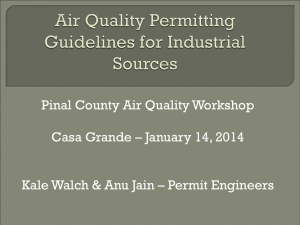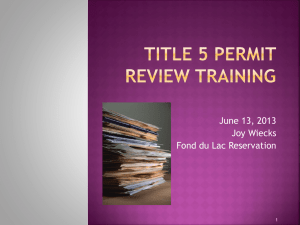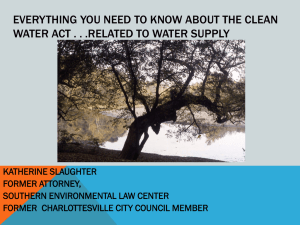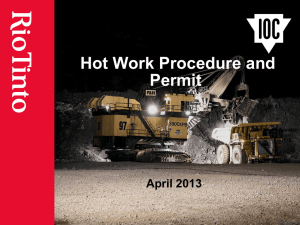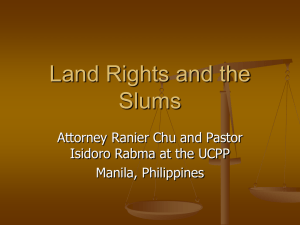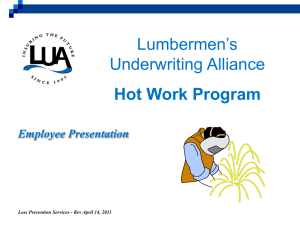Air Quality Regulation in California
advertisement
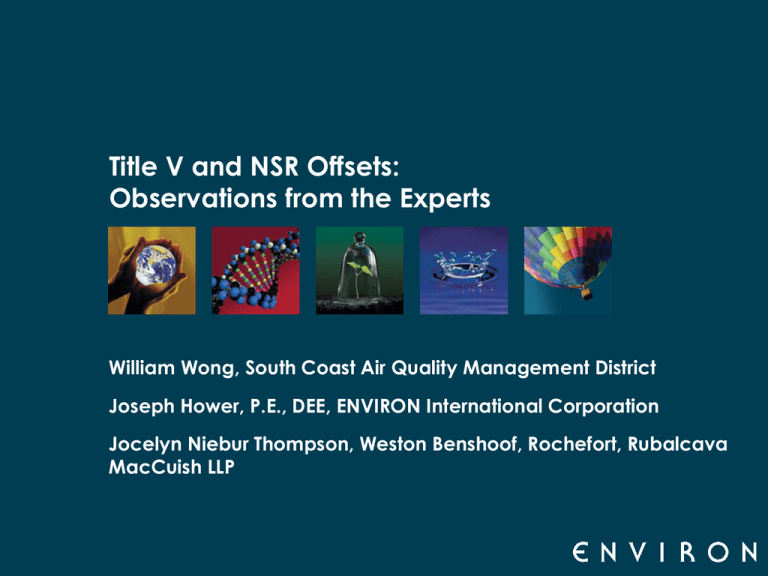
Title V and NSR Offsets: Observations from the Experts William Wong, South Coast Air Quality Management District Joseph Hower, P.E., DEE, ENVIRON International Corporation Jocelyn Niebur Thompson, Weston Benshoof, Rochefort, Rubalcava MacCuish LLP What is Title V? Title V - The Big Picture 1990 CAAA EPA Title I Urban Smog Title II Mobile Sources Administering Agency Title V Permit Title III Air Toxics Title IV Acid Rain Title VI Ozone Layer Facility Title VII Enforcement What is Title V? Permit to Operate Permit D1 Old Permits Conditions Permit D2 Scenario 2 Scenario 1 Permit D3 Facility PTO State Air Rules Federal Program Title V Permit Title V Applicability Title V Major Source Thresholds - PTE Pollutant Classification Threshold (tpy) Ozone Marginal 100 (NOx or VOC) Moderate 100 (NOx or VOC) Serious 50 (NOx or VOC) Severe 25 (NOx or VOC) Extreme 10 (NOx or VOC) HAPs 10 individual / 25 total Synthetic Minor permits Title V Imposes Many Hardships Longer Permit Modification Schedules - Project delays particularly for combined programs Additional Monitoring, Recordkeeping, and Reporting - Deviation Reporting Compliance Certifications More Scrutiny Public and EPA Notice Requirements The only good thing about Title V is that it allows emissions over the thresholds Becoming a Non-Major Source True Minor Categorical Exemptions - Asbestos Demo And Removal - Residential Wood Heaters Physical Demolition SIC Code Groupings Prohibitory Rules Non-federally Enforceable Control Equipment (Temporary) Actuals <50% Of PTE Thresholds - Compliance With SCAQMD Rule 3008 Synthetic Minor Permits Title V is triggered based on Potential emissions, not actuals Many facilities operate far below their potential A way out of Title V for many facilities Must Accept a Cap On Emissions Annual limits vs. monthly Specific language is important Monitoring and Reporting Requirements Can Trigger NSR if the cap is later exceeded FE vs. non-FE provisions in permits DOES YOUR TITLE V PERMIT CONTAIN SOME LOCAL SEASONING? Health & Safety Code Section 42301.12 (a) requires that any Title V permit issued by a district: “Identify in the permit, to the greatest extent feasible, permit terms and conditions which are federally enforceable and those which are not federally enforceable.” 42301.12(a)(3) Federally enforceable conditions are those “imposed pursuant to a federal requirement or because the source has requested [that they be federally enforceable].” 42301.12(a)(3)(A) “[B]ase the reopening [of the Title V permit] upon the federal criteria for reopening and limit the reopening to only the federal component of the Title V permit.” FE vs. non-FE provisions in permits In Re Riverside Cement Co. Background • Riverside Cement Co. appealed the Executive Officer’s deletion from its Title V permit of an erroneous permit condition imposed pursuant to then expired Rule 2009.1, which had not been submitted to EPA and was therefore not federally enforceable. • The Hearing Board, sua sponte, questioned whether the Executive Officer was required to first give notice to EPA pursuant to the District’s Rule 3003(j), which requires notice for any Title V permit revision that is not administrative. • In a split 3-2 decision, the Hearing Board decided on other grounds that the Executive Officer’s action was improper. FE vs. non-FE provisions in permits - Bill DISTRICT POSITION EPA should have no interest in non-federally enforceable conditions placed in Title V permits. EPA POSITION (?) Because the District’s Rule 203, which prohibits operation contrary to permit conditions, is SIPapproved, all District permit conditions are federally-enforceable. Permit Shield Clean Air Act §504; 40 CFR §(f) Offers limited protection from enforcement for requirements not included in permit conditions Optional program: - Air district not required to include in Title V program - If included in program, permit applicant may choose whether to apply Practice varies among districts Permit must explicitly exclude the requirement Circumstances when permit shield would be beneficial Compliance Certifications – Types Deviation Reports Semiannual Monitoring Reports Annual Compliance Certifications Compliance Certifications – Deviation Reports Prompt reporting of deviations from permit requirements (40 CFR § 70.6 (a)(3)(iii)(B)) “Prompt” is defined by the local jurisdiction Reporting deadline may be affected by: - Emergencies Breakdowns Excess emissions Other Compliance Certifications – Semiannual Monitoring Reports Reports of any required monitoring must be submitted at least every 6 months All deviations must be clearly identified Reports must be certified by responsible official 40 CFR §70.6(a)(3)(iii)(A) Compliance Certifications Annual Compliance Certification Compliance certifications must be submitted at least annually Include detailed inventory of permit terms and conditions Identify methods used to determine compliance As to each requirement, specify whether compliance was continuous or intermittent Identify each deviation from permit terms 40 CFR §70.6(c)(5) Compliance Certifications – What is “Reasonable Inquiry”? Mandatory compliance certification language: “Based on information and belief formed after reasonable inquiry, the statements and information in the [application, report or compliance certification] are true, accurate and complete.” 40 CFR §70.5(d) No definition of “reasonable inquiry” Agency tendency to apply hindsight, e.g., if a violation is later found, the inquiry must not have been reasonable Implementation tips Compliance Certifications - Other NSR Permitting – Federal CAA Requirement - Applicability: NSR permitting for a major emitting facility - Scope: Major stationary sources within the state - Status: In compliance or on a schedule of compliance with applicable emissions limits under the CAA - CAA § 173(a)(3); included in local SIP-approved NSR rules NSR Permitting – Additional Local Requirements - Applicability: NSR permitting for any sources Scope: All sources at the facility submitting the application Status: Compliance with all district rules E.g., SCAQMD Rule 1303 (b)(4) Is a variance or abatement order sufficient compliance? Offsets and New Source Review AIR POLLUTION CREDITS – AN ENDANGERED SPECIES?? Background The Federal Offset System: “A key method for controlling air pollution without impeding new economic activity is through "offsetting." Under this strategy, the relevant air pollution control authority, whether it be the EPA or a state or local agency, will permit the creation of a new source of emissions only if the new polluter is able to secure an offsetting reduction in emissions from preexisting polluters at least equal to the amount of pollution the new source could potentially generate.” Santa Barbara County APCD v. U.S. EPA, 31 F.3d 1179, 1181 (DC Cir. 1994) New Source Review CAA Section 173 provides that the District must show that “by the time the source is to commence operation, sufficient offsetting emission reductions have been obtained, such that total allowable emissions from existing sources in the region, from new or modified sources which are not major emitting facilities, and from the proposed source will be sufficiently less than total emissions from existing sources . . . prior to the application for such permit to construct or modify so as to represent (when considered together with the [required] plan provisions . . .) reasonable further progress . . ..” CAA Section 171(3) defines “reasonable further progress” as such “annual incremental reductions in emissions of the relevant air pollutant as are required . . . for the purpose of ensuring attainment of the applicable [NAAQS] by the applicable date.” New Source Review The District has demonstrated to EPA that its more stringent NSR program, while deviating from certain specific EPA requirements, nevertheless overall achieves “reasonable further progress” and is equivalent to the federal program. District offsets minor sources as well as non-major modifications to major sources Minor sources are subject to state BACT or LAER taking into account cost considerations ERC’s are adjusted for BACT. District offset ratio 1.2 : 1 for all pollutants; EPA requires 1: 1 offset for all nonextreme pollutants, currently VOC’s and NOx as ozone precursors. EPA has rescinded 1 hour ozone standard in lieu of 8-hour standard and reclassified the District from extreme to serious-17. The District as well as other states have sued EPA in the case, SCAQMD v. EPA (D.C. Cir) No. 04-1200. A decision is expected within the next few months. New Source Review The State Offset System “Each district with moderate air pollution or worse shall include in its attainment plan “[a] stationary source control program designed to achieve no net increase in emissions of nonattainment pollutants or their precursors from new or modified stationary sources which emit or have the potential to emit [at specified thresholds ]” (Health & Safety Codes Sections 40918 et seq.) CARB has also allowed the District to establish equivalency to the state offset requirement programmatically. Federal requirements for offsets are more stringent than state requirements, and thus District treats federal offsets as meeting state requirements. New Source Review Creation of external offsets (ERC’s) District Rule 1309(b)(4) requires ERC’s to be based on emission reductions that are real, quantifiable, permanent, federally enforceable, and not greater than current BACT (surrogate for being surplus at time of use) Industry has complained that the BACT discount removes any incentive to reduce emissions to create credits. Alternative means of credit generation: - District Regulation XVI (SIP-approved)*: Provides for the creation of mobile source offsets (MSERC’s) - All effectively expired (except Rule 1632 for ship hotelling operations, which expires in 2010). Rule 2507: (SIP-approved) Provides for the creation of area source credits (ASC’s) through the electrification of agricultural pumps - To be used only as RECLAIM Trading Credits or RTC’s. - Effectively expired until EPA, ARB, and the District decide whether these “credits” are still surplus. - *See USA v. Vista Paint Corp., No. 92-55160, 1992 US App. LEXIS 24747 (9th Cir. (Sept. 24, 1992) New Source Review MAXIMIZING CURRENT USE OF CREDITS Amended Rule 1309 (2002) (Not SIP-approved) Provides for the creation of short term credits or STC’s ( in effect yearly ERC’s through 2010 and permanent thereafter.) STC’s include SIP-approved MSERC’s and ASC’s Amended Rule 1309(h) (1995) (SIP-approved) Allows for the creation of interpollutant offsets on a case by case basis. Amended Rule 1309(i) 1995) (SIP-approved) Allows for the creation of inter-basin or inter-district offsets Rule 1303(b) (SIP-approved) Allows netting out of the offset requirement when the proposed source yields no net emission increase at a facility. QUERY: ARE EMISSION REDUCTIONS DISCOUNTED? Rule 1304(c)(2) (SIP-approved) Allows for an offset exemption for concurrent facility modifications Emission reductions are discounted but not BACT-discounted New Source Review Rule 1303(b) (SIP-approved) Allows netting out of the offset requirement when the proposed source yields no net emission increase at a facility. Query: are emission reductions discounted? Rule 1304(c)(2) (SIP-approved) Allows for an offset exemption for concurrent facility modifications Emission reductions are discounted but not BACTdiscounted Getting Credits from the District Bank: Rule 1309.1: (2002 amendments SIP-approved) - Provides designated sources with access to District’s internal bank of offsets New Source Review SB288 – Protect California Air Act of 2003 (Health & Safety Code section 42500 et seq.) Enacted to counter EPA’s NSR Reform Freezes each agency’s NSR rules as of Dec. 30, 2002 Allows agencies to make NSR more stringent Allows agencies to relax NSR only if it meets specified requirements (e.g. substantial hardship) and is approved by CARB Query: Does SB288 apply to offset requirements? CAPCOA: No; CARB: Yes NRDC has petitioned CARB to find District’s Rule 1315 -Federal NSR Tracking System and 2006 amendments to Rule 1309.1 (extending thermal power plant access to Priority Reserve Credits) to violate SB 288 Neither rule affects the amount of offsets required for NSR purposes Early review by CARB of proposed rules disclosed no SB 288 concerns Questions or Comments Joseph Hower, P.E., DEE Managing Principal ENVIRON International Corporation (213) 943-6319, jhower@environcorp.com Jocelyn Niebur Thompson Partner McClintock, Weston, Benshoof, Rochefort, Rubalcava & MacCuish, LLP (213) 576-1104, jocelyn@wbcounsel.com William Wong Senior Deputy Counsel South Coast Air Quality Management District (909) 396-2000, wwong@aqmd.gov

